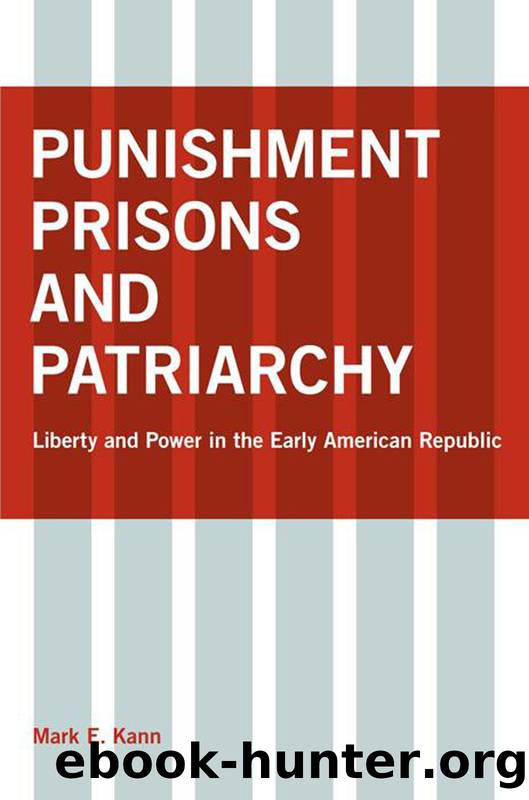Punishment, Prisons, and Patriarchy by Mark E. Kann

Author:Mark E. Kann
Language: eng
Format: epub
Publisher: New York University Press
Published: 2005-12-14T16:00:00+00:00
Expected Outcomes
Reformers expected that the implementation of their recommendations would result in criminalsâ removal from public venues and incarceration behind penitentiary walls, followed by their improved physical and mental health and gradual rehabilitation managed by the paternalistic public officials. âCuredâ convicts would be restored to free society and free society would gain productive, law-abiding citizens who contributed to public order. Overall, crime would be prevented and reduced, and the American republic would be significantly better off.
Most reformers thought that convicts who were denied liberty by way of incarceration simultaneously regained a more meaningful version of liberty upon entering a penitentiary. The new inmate would find himself situated in a controlled environment that helped to free him from the overwhelming passions, destructive habits, abusive and neglectful parents, vicious companions, omnipresent temptations, and corrupt influences that had dominated his life and driven him to crime. The new inmate would soon be free from poor health. Eddy remarked, âMany of those who came into prison with constitutions greatly impaired by excessive drinking, debauchery, and vicious habits, after being some time used to the system of temperance, order, and industry established in the prison, have become healthy and vigorous.â As the inmate shed destructive habits and restored his health, he would acquire positive predispositions that afforded him greater mental clarity and greater control of his life. Solitude would invite him to seek meaning through introspection, remorse, and redemption. Hard labor would instill in him habits of industry and teach him skills that would allow him to contribute to his familyâs well-being while in prison and prepare him for manly independence and respectability when released from prison. Moral and religious instruction would free him to recognize and choose the path of virtue, perhaps for the first time in his life. The inmate even might learn a degree of democratic self-government by joining with other inmates to establish and enforce informal prison regulations (for example, regulations regarding inmate cleanliness) that would improve the quality of convictsâ lives. Rather than dwelling on the lost liberty entailed by imprisonment, the reborn prisoner would feel empowered by his penitentiary experience and would express his âthankfulnessâ to prison officials for helping him to achieve a more disciplined, robust liberty.42
Reformers anticipated that prisoners who underwent rehabilitation regimens would be thankfulâsooner or later. After all, reformers saw themselves as father figures guiding immature males to manhood, as ministers redeeming lost souls, and as physicians healing sick bodies and diseased minds. They loved to relate âwell-authenticated cases of reformationâ that demonstrated how once-dissolute criminals were transformed by penitentiary punishment into upstanding if not exemplary citizens. Reformers fully believed that rehabilitated convicts, on their discharge, would be free to start their lives over again, free to fulfill family responsibilities, free to achieve economic independence, free to enjoy social pastimes, and free to assume the rights and duties of citizenship. Each success story fortified reformersâ conviction that the penitentiary was not a traditional institution of vengeance but, as Pennsylvania inspectors suggested, âa school of reformation.â
Download
This site does not store any files on its server. We only index and link to content provided by other sites. Please contact the content providers to delete copyright contents if any and email us, we'll remove relevant links or contents immediately.
| Africa | Americas |
| Arctic & Antarctica | Asia |
| Australia & Oceania | Europe |
| Middle East | Russia |
| United States | World |
| Ancient Civilizations | Military |
| Historical Study & Educational Resources |
Machine Learning at Scale with H2O by Gregory Keys | David Whiting(4187)
Never by Ken Follett(3795)
Fairy Tale by Stephen King(3220)
The Man Who Died Twice by Richard Osman(2997)
Oathbringer (The Stormlight Archive, Book 3) by Brandon Sanderson(2888)
Will by Will Smith(2794)
Rationality by Steven Pinker(2291)
The Dark Hours by Michael Connelly(2246)
Can't Hurt Me: Master Your Mind and Defy the Odds - Clean Edition by David Goggins(2229)
The Dawn of Everything: A New History of Humanity by David Graeber & David Wengrow(2122)
Friends, Lovers, and the Big Terrible Thing by Matthew Perry(2120)
Principles for Dealing With the Changing World Order: Why Nations Succeed and Fail by Ray Dalio(1974)
HBR's 10 Must Reads 2022 by Harvard Business Review(1778)
A Short History of War by Jeremy Black(1763)
Go Tell the Bees That I Am Gone by Diana Gabaldon(1687)
515945210 by Unknown(1600)
A Game of Thrones (The Illustrated Edition) by George R. R. Martin(1591)
Kingdom of Ash by Maas Sarah J(1529)
443319537 by Unknown(1470)
